|
10 Worlds Weirdest Animals
Sun Bear The Sun Bear (Helarctos malayanus) is a bear found primarily in the tropical rainforests of Southeast Asia.
The Sun Bear stands approximately 4 ft (1.2 m) in length, making it the smallest member in the bear family. It is often called the dog bear because of its small stature. It has a 2 in (5 cm) tail and on average weighs less than 145 lb (65 kg). Males tend to be slightly larger than females.
Unlike other bears, the Sun Bear's fur is short and sleek. This adaptation is probably due to the lowland climates it inhabits. Dark black or brown-black fur covers its body, except on the chest where there is a pale orange-yellow marking in the shape of a horseshoe. Similar colored fur can be found around the muzzle and the eyes. This distinct marking gives the sun bear its name.

Angora Rabbit The Angora rabbit is a variety of domestic rabbit bred for its long, soft hair. The Angora is one of the oldest types of domestic rabbit, originating in Ankara, Turkey, along with the Angora cat and Angora goat. The rabbits were popular pets with French royalty in the mid 1700s, and spread to other parts of Europe by the end of the century. They first appeared in the United States in the early 1900s. They are bred largely for their long wool, which may be removed by shearing or plucking (gently pulling loose wool).
There are many individual breeds of Angora rabbits, four of which are ARBA recognized. Such breeds include, French, German, Giant, English, Satin, Chinese, Swiss, Finnish, to name a few.
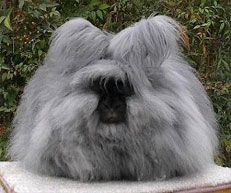
Red Panda The Red Panda, Ailurus fulgens ("shining cat," from a Latinized form of the Greek, ailouros, "cat," and the participial form of the Latin fulgere, "to shine") is a mostly herbivorous mammal, slightly larger than a domestic cat (55 cm long). The Red Panda has semi-retractile claws and, like the Giant Panda, has a "false thumb" which is really an extension of the wrist bone. Thick fur on the soles of the feet offers protection from cold and hides scent glands. The Red Panda is native to the Himalayas in Nepal and southern China. The word panda is derived from Nepalese word "ponya" which means bamboo and plants eating animals in Nepal.
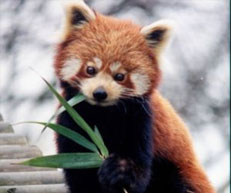
Proboscis Monkey Nasalis larvatus also known as Long-nosed Monkey is a reddish-brown arboreal Old World monkey. It is the only species in monotypic genus Nasalis.
The most distinctive trait of this monkey is the male's large protruding nose. The purpose of the large nose is unclear, but it has been suggested that it is a result of sexual selection. The female Proboscis Monkey prefers big-nosed male, thus propagating the trait.
Males are much larger than females, reaching 72 cm (28 inches) in length, with an up to 75 cm tail, and weighing up to 24 kg (53 pounds). Females are up to 60 cm long, weighing up to 12 kg (26 lb).
The Proboscis Monkey also has a large belly, as a result of its diet. Its digestive system is divided into several parts, with distinctive gut flora, which help in digesting leaves. This digestive process releases a lot of gas, resulting in the monkey's "bloated" bellies. A side-effect of this unique digestive system is that it is unable to digest ripe fruit, unlike most other simians. The diet consists mainly of fruits, seeds and leaves.
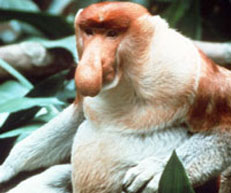
Axolotl The Axolotl (or ajolote) (Ambystoma mexicanum) is the best-known of the Mexican neotenic mole salamanders belonging to the Tiger Salamander complex. Larvae of this species fail to undergo metamorphosis, so the adults remain aquatic and gilled. The species originates from the lake underlying Mexico City. Axolotls are used extensively in scientific research due to their ability to regenerate most body parts, ease of breeding, and large embryos. They are commonly kept as pets in the United States, Great Britain, Australia, Japan (where they are sold under the name Wooper Rooper, and other countries.
Axolotls should not be confused with waterdogs, the larval stage of the closely related Tiger Salamanders (Ambystoma tigrinum and Ambystoma mavortium), which is widespread in much of North America which also occasionally become neotenic, nor with mudpuppies (Necturus spp.), fully aquatic salamanders which are unrelated to the axolotl but which bear a superficial resemblance.
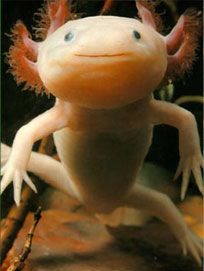
Aye-aye The Aye-aye (Daubentonia madagascariensis) is a strepsirrhine native to Madagascar that combines rodent-like teeth with a long, thin middle finger to fill the same ecological niche as a woodpecker. It is the world's largest nocturnal primate, and is characterized by its unique method of finding food; it taps on trees to find grubs, then gnaws holes in the wood and inserts its elongated middle finger to pull the grubs out.
Daubentonia is the only genus in the family Daubentoniidae and infraorder Chiromyiformes. The Aye-aye is the only extant member of the genus (although it is currently an endangered species); a second species (Daubentonia robusta) was exterminated over the last few centuries.
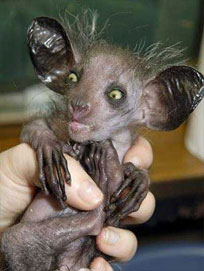
Alpaca The Alpaca (Vicugna pacos) is a domesticated species of South American camelid developed from the wild alpacas. It resembles a sheep in appearance, but is larger and has a long erect neck as well as coming in many colors, whereas sheep are generally bred to be white and black.
Alpacas are kept in herds that graze on the level heights of the Andes of Ecuador, southern Peru, northern Bolivia, and northern Chile at an altitude of 3500 to 5000 meters above sea-level, throughout the year.
Alpacas are considerably smaller than llamas, and unlike them are not used as beasts of burden but are valued only for their fiber. Alpacas only have fleece fibers, not woolen fibers, used for making knitted and woven items much as sheeps wool is. These items include blankets, sweaters, hats, gloves, scarves, a wide variety of textiles and ponchos in South America, and sweaters, socks and coats in other parts of the world. The fiber comes in more than 52 natural colors as classified in Peru, 12 as classified in Australia and 22 as classified in America.
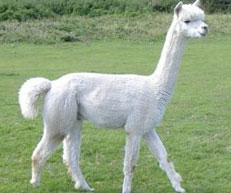
Tarsier Tarsiers are prosimian primates of the genus Tarsius, a monotypic genus in the family Tarsiidae, which is itself the lone extant family within the infraorder Tarsiiformes. The phylogenetic position of extant tarsiers within the order Primates has been debated for much of the past century, and tarsiers have alternately been classified with strepsirrhine primates in the suborder Prosimii, or as the sister group to the simians (=Anthropoidea) in the infraorder Haplorrhini. Analysis of SINE insertions, a type of macromutation to the DNA, is argued to offer very persuasive evidence for the monophyly of Haplorrhini, where other lines of evidence, such as DNA sequence data, had remained ambiguous. Thus, some systematists argue that the debate is conclusively settled in favor of a monophyletic Haplorrhini.
Tarsiers have enormous eyes and long feet. Their feet have extremely elongated tarsus bones, which is how they got their name. They are primarily insectivorous, and catch insects by jumping at them. They are also known to prey on birds and snakes. As they jump from tree to tree, tarsiers can catch even birds in motion.[citation needed] Gestation takes about six months, and tarsiers give birth to single offspring. All tarsier species are nocturnal in their habits, but like many nocturnal organisms some individuals may show more or less activity during the daytime. Unlike many nocturnal animals, however, tarsiers lack a light-reflecting area (tapetum lucidum) of the eye. They also have a fovea, atypical for nocturnal animals.
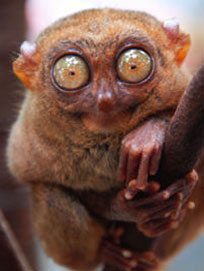
Pygmy Marmoset The Pygmy Marmoset (Callithrix (Cebuella) pygmaea) is a monkey native to the rainforest canopies of western Brazil, southeastern Colombia, eastern Ecuador, and eastern Peru. It is one of the smallest primates, with its body length ranging from 14-16 cm (excluding the 15-20 cm tail) and the smallest monkey. Males weigh around 140 g (5 ounces), and females only 120 g (4.2 ounces).
TDespite its name, the Pygmy Marmoset is somewhat different from the typical marmosets classified in genus Callithrix. As such, it is accorded its own subgenus, which was formerly recognized as its own genus, Cebuella.
TThe Pygmy Marmoset has a tawny coat, and a ringed tail that can be as long as its body. Their claws are specially adapted for climbing trees, a trait unique to the species. They are omnivorous, feeding on fruit, leaves, insects, and sometimes even small reptiles. Much of their diet, however, comes from tapping trees for sap. Up to two-thirds of their time is spent gouging tree bark to reach the gummy sap. The Pygmy Marmoset has specialized incisors for gouging holes in bark. Unfortunately, because of its small size, and its swift movements, it is very hard to observe in the wild.
TIn captivity, the Pygmy Marmoset can live up to 11 years.
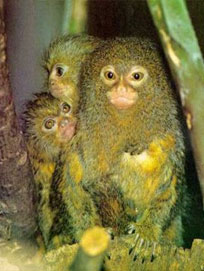
Shoebill The Shoebill, Balaeniceps rex also known as Whalehead is a very large bird related to the storks. It derives its name from its massive shoe-shaped bill.
The Shoebill is a very large bird, averaging 1.2 m (4 ft) tall, 5.6 kg (12.3 lbs) and 2.33 m (7.7 ft) across the wings. The adult is mainly grey, the juveniles are browner. It lives in tropical east Africa, in large swamps from Sudan to Zambia.
The Shoebill was added rather recently to the ornithological lists; the species was only discovered in the 19th century when some skins were brought to Europe. It was not until years later that live specimens reached the scientific community. The bird was known to both ancient Egyptians and Arabs however. There exist Egyptian images depicting the Shoebill while the Arabs referred to the bird as abu markub, which means one with a shoe. Clearly, this refers to the striking bill.

|




 Show Printable Version
Show Printable Version
 Email this Page
08-20-2010, 08:18 PM
Email this Page
08-20-2010, 08:18 PM











 Show Printable Version
Show Printable Version
 Email this Page
08-20-2010, 08:21 PM
Email this Page
08-20-2010, 08:21 PM

 Show Printable Version
Show Printable Version
 Email this Page
08-20-2010, 08:23 PM
Email this Page
08-20-2010, 08:23 PM

 Show Printable Version
Show Printable Version
 Email this Page
08-23-2010, 01:58 AM
Email this Page
08-23-2010, 01:58 AM

 Show Printable Version
Show Printable Version
 Email this Page
08-23-2010, 02:06 AM
Email this Page
08-23-2010, 02:06 AM

 Show Printable Version
Show Printable Version
 Email this Page
08-23-2010, 03:14 AM
Email this Page
08-23-2010, 03:14 AM

 Show Printable Version
Show Printable Version
 Email this Page
08-23-2010, 03:29 AM
Email this Page
08-23-2010, 03:29 AM

 Show Printable Version
Show Printable Version
 Email this Page
08-23-2010, 12:08 PM
Email this Page
08-23-2010, 12:08 PM

 Show Printable Version
Show Printable Version
 Email this Page
08-23-2010, 08:34 PM
Email this Page
08-23-2010, 08:34 PM

 Show Printable Version
Show Printable Version
 Email this Page
08-24-2010, 04:52 AM
Email this Page
08-24-2010, 04:52 AM


 Similar Threads
Similar Threads